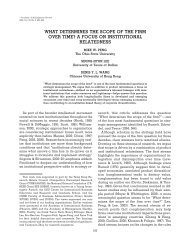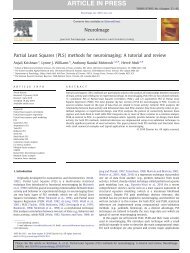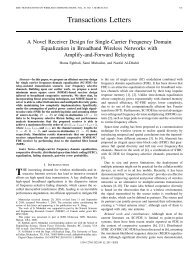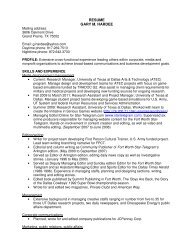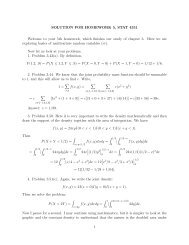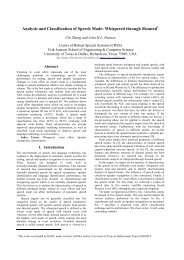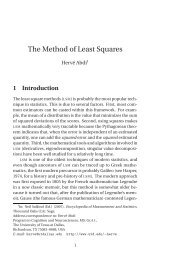Curriculum Vitae - The University of Texas at Dallas
Curriculum Vitae - The University of Texas at Dallas
Curriculum Vitae - The University of Texas at Dallas
You also want an ePaper? Increase the reach of your titles
YUMPU automatically turns print PDFs into web optimized ePapers that Google loves.
the concepts in semantic nets and conceptual graphs and developed methods for secure applic<strong>at</strong>ionsdesign. A paper titled “On the Use <strong>of</strong> Conceptual Structures for Handling the Inference Problem”published in IFIP D<strong>at</strong>a Security Conference in 1991 is widely quoted and Dr. Thomas Hinke and his teambased their research on my work. At th<strong>at</strong> time, the d<strong>at</strong>abase security community was divided about theapproach to designing inference controllers. Many felt th<strong>at</strong> it had to be done during d<strong>at</strong>abase design time.However, I was perhaps one <strong>of</strong> a handful <strong>of</strong> researchers who was far-thinking. I believed th<strong>at</strong> a timewould come where we would have the technologies to address the limit<strong>at</strong>ions we had in 1990. <strong>The</strong>refore, Ifelt th<strong>at</strong> we needed an integr<strong>at</strong>ed approach to study the inference problem, during query, upd<strong>at</strong>e andd<strong>at</strong>abase design. Some researchers from the <strong>University</strong> <strong>of</strong> <strong>Texas</strong> <strong>at</strong> th<strong>at</strong> time agreed with me and publishedin the Proceedings <strong>of</strong> the 1991 Computer Security Applic<strong>at</strong>ions Conference something to the effect th<strong>at</strong>“Thuraisingham’s approach was correct”. Now, almost 20 years l<strong>at</strong>er, it is my approach th<strong>at</strong> the semanticweb community is pursuing–including Dr. Tim Finin and his team <strong>at</strong> the <strong>University</strong> <strong>of</strong> Maryland,Baltimore County and Sir Tim Berners Lee and his team <strong>at</strong> MIT. We are also developing inferencecontrollers during query processing with semantic web technologies since 2005. My research on theinference problem has resulted in three US P<strong>at</strong>ents. <strong>The</strong>se p<strong>at</strong>ents are widely cited in numerous otherp<strong>at</strong>ents, and have been purchased by Intellectual Ventures from MITRE for a substantial sum <strong>of</strong> money (Iwas told th<strong>at</strong> my p<strong>at</strong>ents were three <strong>of</strong> the four “must have” p<strong>at</strong>ents Intellectual Ventures wanted).As st<strong>at</strong>ed earlier, the third area I focused back in l<strong>at</strong>e 1980s was on secure objects. After working on thefirst secure object system with the team <strong>at</strong> the <strong>University</strong> <strong>of</strong> Minnesota, I felt th<strong>at</strong> we had to look <strong>at</strong>existing object models and examine security issues. My paper on SORION (which incorpor<strong>at</strong>ed securityinto ORION) was published in the highly prestigious conference ACM OOPSLA. This paper is titled“Mand<strong>at</strong>ory Security in Object D<strong>at</strong>abase System” and is widely cited. Pr<strong>of</strong>. Elisa Bertino from Purdue hasst<strong>at</strong>ed th<strong>at</strong> this paper is a “must read” for anyone wanting to work in object security. This was followed bythe design and implement<strong>at</strong>ion <strong>of</strong> a system using ObjectStore d<strong>at</strong>a manager and we presented the results toOntos Corpor<strong>at</strong>ion which was developing the first commercial secure object d<strong>at</strong>abase system with fundingfrom the Air Force.Around 1992, while continuing to work in secure d<strong>at</strong>abases, I then started to get into a new area and th<strong>at</strong> isreal-time d<strong>at</strong>a management. This was because the Air Force had a critical need to modernize the oldsystems such as AWACS (Airborne Warning and Control System). Because <strong>of</strong> my strong expertise in d<strong>at</strong>amanagement, I was invited to join the team. <strong>The</strong> contributions we made here are long-lasting. Wepublished papers in the main conferences and workshops in object real-time systems and they are widelycited. While working with the team to design and develop a main memory d<strong>at</strong>a manager based on objectsand adapt the priority ceiling concurrency control protocol for the d<strong>at</strong>a manager, I was the first tointroduce real-time fe<strong>at</strong>ures for Object Request Brokers. I first presented this work <strong>at</strong> the Navy’s NextGener<strong>at</strong>ion Standards meeting in Newport, Rhode Island in June 1994. <strong>The</strong>n, with the team, we wrote aposition paper and presented it <strong>at</strong> OOPSLA 1994 workshop. I then used some <strong>of</strong> my ideas into buildingthe infrastructure for AWACS. In August 1995, I was invited to particip<strong>at</strong>e in a panel <strong>at</strong> Object World inSan Francisco. At the end <strong>of</strong> my talk I said, “It’s time for OMG (Object Management Group) to start aspecial interest group on this topic”. I was contacted by some people who <strong>at</strong>tended OMG, and I gave sometechnical present<strong>at</strong>ions to them and helped co-found the group. This was a huge breakthrough as thosewho were going to oper<strong>at</strong>ionalize the prototypes we had developed would now have standards to workwith for the middleware. During this time I also wanted to combine my work in security and real-time tobuild dependable systems. I presented some ideas <strong>at</strong> a Navy meeting in December 1992, and got Pr<strong>of</strong>.Sang Son from the <strong>University</strong> <strong>of</strong> Virginia interested in this topic and we collabor<strong>at</strong>ed on a few papers.<strong>The</strong>n I combined all my ideas together in a design <strong>of</strong> a dependable system and this paper was published inIEEE Transactions on Knowledge and D<strong>at</strong>a Engineering in 1999 which spawned a new area <strong>of</strong> research.During 1995 I was given the role <strong>of</strong> managing a department in inform<strong>at</strong>ion and d<strong>at</strong>a management. Iintroduced d<strong>at</strong>a mining to MITRE Corpor<strong>at</strong>ion in October 1995. My colleague Dr. Chris Clifton (who isnow <strong>at</strong> Purdue and who was in my department) worked with me and we put together three programs ind<strong>at</strong>a, text and image mining. One <strong>of</strong> the projects was jointly carried out with Pr<strong>of</strong>. Jeff Ullman <strong>of</strong> Stanford<strong>University</strong> and Sergey Brin (who is the co-founder <strong>of</strong> Google). Sergey had planned his thesis to be on <strong>at</strong>opic called Query Flocks. I engineered this collabor<strong>at</strong>ion between MITRE and Stanford which gaveMITRE tremendous visibility among the major players in d<strong>at</strong>a mining. <strong>The</strong> two teams published a paper9



